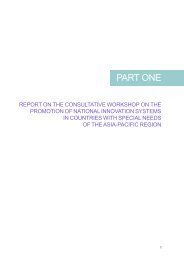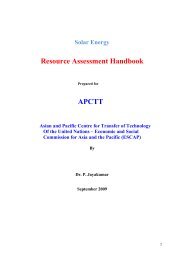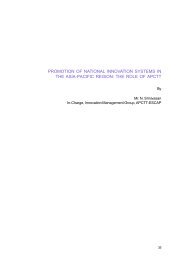Download Complete PDF - apctt
Download Complete PDF - apctt
Download Complete PDF - apctt
- No tags were found...
You also want an ePaper? Increase the reach of your titles
YUMPU automatically turns print PDFs into web optimized ePapers that Google loves.
Compared with conventional power plants, coal gasification has several environmentalbenefits such as: 11.7 per cent less CO 2; 86.6 per cent less NOx; 93.4 per cent lessSOx; almost no particulate emissions; and 38.5 per cent less water utilization. Acomparison of emissions and resource utilization for different electricity generationtechnologies is given in Table 3-7. Converting coal to a liquid fuel (CTL) allows coal tobe utilized as an alternative to petroleum oil.Table 3-7: A comparison of different electricity generation technologiesEmission Pulverized coal Gasification Combined natural gascombustioncombustionCO 2(kg/kWh) 0.77 0.680 0.36SO 2(kg/MWh) 0.68 0.045 0.00NOx (kg/MWh) 0.61 0.082 0.09Water use (L/kWh) 4.62 2.840 2.16India needs a paradigm shift in technology intervention that involves poly-generationand multi-level utilization of gasification technology. Gasification facilities use a rangeof carbon-based feedstocks, such as natural gas, coal, petroleum, petcoke, biomassand industrial wastes. Currently, coal dominates as the feedstock with 36,315 MW thor51 per cent of the global syngas capacity (Figure 3-12). Petroleum fuels are the secondleading feedstock, with 17,938 MW thor 25 per cent of the total gasification capacity.80,000Figure 3-12: Global syngas capacity by feedstockSyngas (MWth)70,00060,00050,00040,00030,00020,00010,000In operationUnder constructionIn planning0Coal Petroleum Gas Petcoke Biomass/wasteAt present, Thermax is executing the following three projects in collaboration withvarious partner institutions:98







